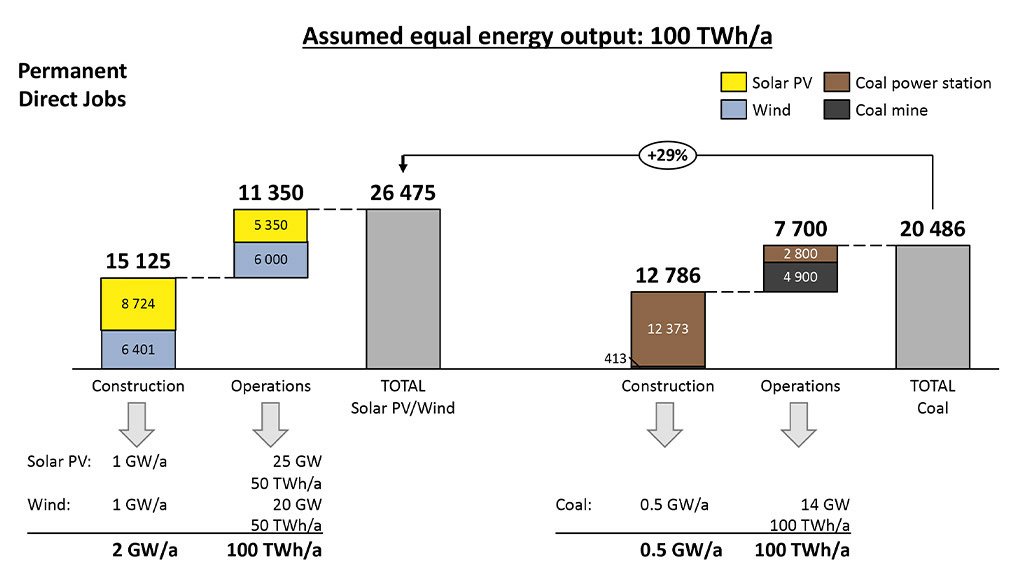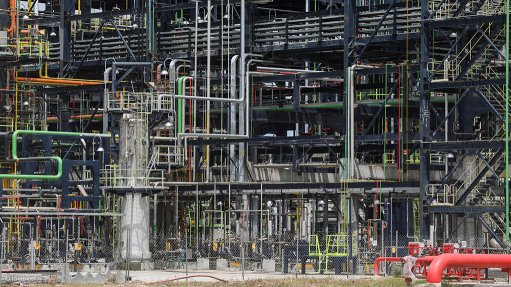Opinion: Are there really more jobs in coal than in renewables?



More jobs in renewables than coal to meet a theoretical 100 TWh yearly energy output profile
Photo by Tobias Bischof-Niemz
Dr Tobias Bischof-Niemz
There is considerable support in South Africa for the notion that a transition in the electricity system from coal to renewable energy will trigger a jobs bloodbath at both Eskom and the Mpumalanga coal mines. A detailed analysis of the job numbers, however, suggests quite the opposite. In fact, it points to there being at least 30% more jobs in a fleet comprising solar photovoltaic (PV) and wind farms when compared with an energy-equivalent coal fleet.
The Department of Energy’s (DoE’s) Integrated Energy Plan includes a study on the job-intensity of different power-generating technologies. Applying these assumptions to two hypothetical power systems with the same yearly energy output will be indicative. To achieve a 100 terrawatt-hour per annum (TWh/a) production rate with coal-fired power stations, a 14 GW fleet would have to be built, operated and maintained in perpetuity. With a lifetime assumption of 30 years, roughly 0.5 GW of new coal-fired plant would need to be built yearly, in perpetuity, to sustain the 100 TWh/a output. Applying the DoE job-intensity data suggests that such a fleet would create 20 486 permanent direct jobs in construction (at the 0.5 GW/a build rate) and operations of the associated coal mines and the power stations.
Achieving the same 100 TWh yearly outcome using wind and solar PV plants would require a 45 GW fleet, comprising 25 GW of solar PV capacity to produce 50 TWh/a and a 20 GW wind fleet to produce the 50 TWh/a balance. Solar PV plants have a lifetime of 25 years, wind farms 20 years. Hence, 1 GW each would need to be built yearly, in perpetuity, to keep the output constant at 100 TWh/a. Building and operating such a fleet in perpetuity will require 26 475 permanent direct jobs – 15 125 in construction and 11 350 in operations. Hence, significantly more jobs are needed to build and operate a renewables fleet in perpetuity than is the case for a system based on coal, and that is without adding the jobs required in the flexible power stations, such as gas, biogas or batteries, needed to balance the renewables-based system.
How do these theoretical numbers compare with reality?
Since inception of the Renewable Energy Independent Power Producer Procurement Programme (REIPPPP) in 2011 to June 2018, some 3 800 MW of new capacity was built, yielding a total of 26.8 TWh of electricity. During this period, the programme needed 31 072 job-years in construction and 5 456 job-years in operations. This equates to a job-intensity of nearly 8 200 construction job-years for every 1 GW of newly installed capacity and 203 job-years for every 1 TWh produced. Therefore, if South Africa consistently builds new wind and solar capacity at a yearly rate of 2 GW (1 GW each), as per the theoretical example above, 16 400 permanent jobs are created – more than 1 000 more than what the DoE job-intensity assumptions suggest at such a new-build rate. The 100 TWh yearly electricity production would lead to 20 300 permanent jobs in operations of the wind and solar PV fleet, based on the actual job-intensity of the REIPPPP – almost twice the number based on DoE job-intensity assumptions. Hence, domestically achieved actual job-intensity numbers over-confirm the DoE’s assumptions.
Internationally, an in-depth study published by the US Department of Energy in 2018, titled ‘US Energy Employment Report’ revealed that the solar PV and wind industries in America employed 475 000 people in 2018 compared with only 240 000 people in the nuclear and coal sectors combined. That figure becomes all the more impressive when one considers that wind and solar PV are still supplying only 10% of America’s electricity demand, against 60% from nuclear and coal plants.
The net jobs picture may be overwhelmingly positive for renewables, but in South Africa it remains hidden behind the distributed nature of the wind and solar investments, against the very high concentrated-ness of coal in Mpumalanga and the Free State. It is, thus, natural for coal workers and communities to feel threatened by a transition to renewables, as the net jobs benefit is meaningless unless it also translates into a real job for the individual employed either at a mine or a power station.
Internationally, initiatives to cushion such individuals and communities from the negative effects of a shift from coal to renewables have been collectively clustered under the so-called ‘just energy transition’. What such a just transition could mean in the South African context, is the theme of my next column, which poses the question: If there are more jobs in renewables, why are coal miners so unhappy?
Dr Bischof-Niemz is one of the authors of a book titled 'South Africa’s Energy Transition', which offers a roadmap to a decarbonised, low-cost and job-rich energy future. He was the founding head of the CSIR Energy Centre and previously worked for Eskom on the Integrated Resource Plan. He is currently CEO of ENERTRAG South Africa – tobias@bischof-niemz.de
Comments
Announcements
What's On
Subscribe to improve your user experience...
Option 1 (equivalent of R125 a month):
Receive a weekly copy of Creamer Media's Engineering News & Mining Weekly magazine
(print copy for those in South Africa and e-magazine for those outside of South Africa)
Receive daily email newsletters
Access to full search results
Access archive of magazine back copies
Access to Projects in Progress
Access to ONE Research Report of your choice in PDF format
Option 2 (equivalent of R375 a month):
All benefits from Option 1
PLUS
Access to Creamer Media's Research Channel Africa for ALL Research Reports, in PDF format, on various industrial and mining sectors
including Electricity; Water; Energy Transition; Hydrogen; Roads, Rail and Ports; Coal; Gold; Platinum; Battery Metals; etc.
Already a subscriber?
Forgotten your password?
Receive weekly copy of Creamer Media's Engineering News & Mining Weekly magazine (print copy for those in South Africa and e-magazine for those outside of South Africa)
➕
Recieve daily email newsletters
➕
Access to full search results
➕
Access archive of magazine back copies
➕
Access to Projects in Progress
➕
Access to ONE Research Report of your choice in PDF format
RESEARCH CHANNEL AFRICA
R4500 (equivalent of R375 a month)
SUBSCRIBEAll benefits from Option 1
➕
Access to Creamer Media's Research Channel Africa for ALL Research Reports on various industrial and mining sectors, in PDF format, including on:
Electricity
➕
Water
➕
Energy Transition
➕
Hydrogen
➕
Roads, Rail and Ports
➕
Coal
➕
Gold
➕
Platinum
➕
Battery Metals
➕
etc.
Receive all benefits from Option 1 or Option 2 delivered to numerous people at your company
➕
Multiple User names and Passwords for simultaneous log-ins
➕
Intranet integration access to all in your organisation




















